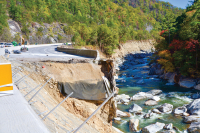‘Big Ice’ links flora and fauna here and in Asia
When walking a trail in the Smokies (or Nantahalas or Great Balsams or wherever) here in the southern Blue Ridge, I sometimes pause to observe the landscapes and flora and imagine that I’m in the mountains of northern Japan or eastern China. Botanists are familiar with a concept sometimes known as “The Asian Connection.” In Hollows, Peepers, and Highlanders: An Appalachian Ecology (1994), George Constantz devotes an entire chapter to this topic.
“Here’s a claim that might surprise you,” Constantz noted. “The forests of eastern Asia and southern Appalachia are so similar that if you were swept from one to the other you would be hard pressed to tell them apart.”
He went on to explain that, “At the genus and species levels this similarity involves more than 50 genera of Appalachian plants that are restricted to eastern North America and eastern Asia and, except in fossil form, are absent in between.”
The ginseng trade was, of course, established due to this connection, with the North American species being closely related to the various Asian species and supposed to have similar medicinal virtues. And, as Constantz also pointed out, “More than two-thirds of the total orchid genera of temperate North America are related to orchid species in eastern Asia,”
In The Woods of Time (1957), Rutherford Platt listed other plants that have exact or very closely related genera and species, one residing in eastern Asia and the other in the Appalachians: oak, elm, basswood, beech, hickory, maple, birch, hemlock, persimmon, yellowwood, sassafras, tulip poplar, sumac, bittersweet, columbine, hepatica, Dutchman’s-breeches, dwarf ginseng, skunk cabbage, wild geranium, May apple, partridgeberry, sassafras, silverbell, witch hazel, stewartia, and Hercules-club.
In A Natural History of Ferns (2004), Robbin Moran noted that, “These two regions share more genera and species than any other two regions on earth.” Of the 120 or so species found on the Japanese island of Hokkaido, 47 of them are found in eastern North America, including maidenhair fern, slivery glade fern, interrupted fern, and marsh fern.
Related Items
Why do we have an Asian connection? Here’s the short answer, as I have pieced it together from various sources. When the giant super continent of Pangea was being formed between 300 and 250 million years ago, numerous plant communities were contiguous across a circumpolar landmass that included Asia, Europe, and North America. When Pangea split up some millions of years later, the vestiges of this plant community died out in Europe, western Asia, and western North America, leaving the Asian and Appalachian communities intact but widely separated.
In turn, these remnant communities survived various climate changes. The most dramatic of these, by far, occurred during the Ice Ages. (The last truly cold interval, the Wisconsin epoch, reached its apogee about 18,000 years ago.) The southern Asian mountains and the southern Appalachians escaped being glaciated because both terrains have north-south conformities that impeded the oncoming ice sheets.
I do not know how far south glaciation extended in Asia, but in the Appalachians there was no true glaciation any farther south than northeastern Pennsylvania, although it was, of course, very cold here in the Blue Ridge and adjacent upland terrains. On the other hand, in the Mississippi River valley, where there were no uplands capable of resisting glaciation, the ice sheets extended much farther south to the outskirts of present day Cincinnati.
Platt explained that this trans-world plant connection wasn’t revealed until after trade was opened with Japan in the mid-19th century and plant hunters like E.H. Wilson of the Arnold Arboretum began to return to America with extensive collections that matched our southern Appalachian flora.
By this time, the European-born glaciologist Louis Agassiz had journeyed to American and announced “the sensational discovery of the Big Ice visit to the United States.” Asa Gray, this country’s first great botanist, “put together the Big Ice story and the discovery of the same flora, separated by half the world, and announced in a sensational address, in 1858, that the Big Ice had arranged the world that way.”
George Ellison wrote the biographical introductions for the reissues of two Appalachian classics: Horace Kephart’s Our Southern Highlanders and James Mooney’s History, Myths, and Sacred Formulas of the Cherokees. In June 2005, a selection of his Back Then columns was published by The History Press in Charleston as Mountain Passages: Natural and Cultural History of Western North Carolina and the Great Smoky Mountains. Readers can contact him at P.O. Box 1262, Bryson City, N.C., 28713, or at This email address is being protected from spambots. You need JavaScript enabled to view it..









